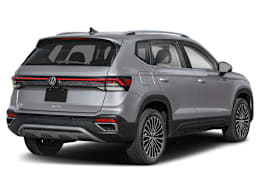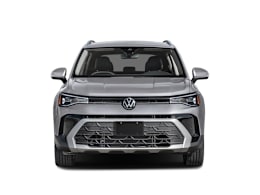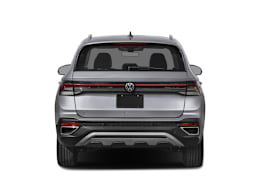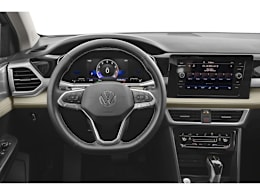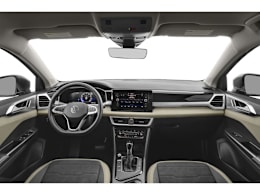Volkswagen gave its Taos subcompact SUV a relatively significant refresh for 2025, with the biggest changes centering on the transmission and controls. The new eight-speed automatic, which replaces the balky seven-speed dual-clutch transmission the Taos previously used in all-wheel-drive models, makes for a more refined vehicle. The 1.5-liter turbocharged four-cylinder engine also received a 16-horsepower boost, now at 174 hp. Altogether, the Taos' power delivery is now more responsive and predictable, particularly at lower speeds.
But the good vibes VW gained with the transmission have been diminished by the new climate controls. VW replaced the conventional knobs and buttons that the Taos previously used with capacitive-touch sliders and “buttons.” We found them distracting to use, as they lack the tactile feedback of physical controls.
Still, there’s a lot to like about the Taos, and much of what worked before was carried over through the redesign. As one tester said, “I like it! It’s just a basic vehicle that’s easy to live with.”
“The Taos was completely off the map before,” said another tester. “Now it’s a mostly pleasant and practical vehicle that even excels in some areas. I do feel that by removing the dual-clutch transmission, they traded one powertrain issue for another, though. Gone are the low-speed delays, but now the shifts are slower and at times more noticeable. Still, it’s worth the trade in my opinion.”
The Taos’ handling agility, at least, was never in doubt. It’s a nimble, eager SUV that’s as at home on twisty roads as it is cruising the interstate at a steady speed. The ride is on the firm side, like many German SUVs, but it isn’t objectionable and is on a par with the rest of the subcompact SUV class.
Passenger space, seat comfort, and cargo room are all high points. The front seats are comfortable and supportive, and there’s tons of headroom. The rear seat is almost shockingly spacious for this segment, and cargo room remains impressive thanks to the big, square storage area.
Buyers should keep some things in mind, though. The Taos’ premium price puts it a few thousand dollars above other subcompact SUVs that offer very similar passenger and cargo room, better fuel economy, and easier-to-use controls. And the Taos’ below-average reliability since its introduction is cause for concern, especially after the new-vehicle warranty runs out.
Volkswagen offers the Taos in four trims: S, SE, SE Black, and SEL. Front-wheel drive is standard on the S, SE, and SE Black, and each can be configured with all-wheel drive. The SEL is only available with all-wheel drive.
We bought a 2025 Volkswagen Taos SE 4Motion for $32,811—anonymously from an area dealer, as we do with every vehicle we test—for the purpose of this road test review. The Taos is assembled in Puebla, Mexico.
Driving experience
The Taos’ compact dimensions, responsive steering, and taut suspension help it take turns with a sprightly eagerness. We found the steering feels overly light in its Normal drive setting, but it firms up at higher speeds, which improves driver confidence.
It proved a willing partner when driven to its limits around our test track, carving through corners with good precision. However, its speed through our avoidance maneuver—which simulates swerving quickly to avoid a vehicle or an obstacle on the road—was a bit slower than most rivals because its electronic stability control (ESC) system kicks in aggressively to help keep the vehicle in control.
The ride is on the firm side, like many German SUVs, but it isn’t objectionable, and it’s on a par with most subcompact SUVs in the way it absorbs impacts from potholes and other road imperfections. We found that the Taos rides slightly better than before, partially chalked up to the smaller 18-inch wheels and tires on our 2025 Taos vs. the 19-inchers on the 2022 model we last tested. While the Taos’ suspension is capable of keeping the truly harsh stuff out of the cabin, it’s no match for the absorbent ride of the Subaru Crosstrek.
The Taos’s 174-hp, 1.5-liter turbocharged four-cylinder engine gives the little SUV good passing power, but some turbo lag can make it feel a bit lethargic during around-town driving. Its fuel economy of 26 mpg overall in our testing is a bit low for a small all-wheel-drive SUV, lagging a few mpg behind the class leaders, most notably the Crosstrek.
Cabin comfort
We liked our test model’s two-tone seats and trim throughout. Although the cabin has an abundance of hard plastic panels, it has a slightly upscale look and feels solidly built. Items such as the suede-like trim that runs across the dashboard and flows into the doors is pretty nice at this price point.
Passenger space, seat comfort, and cargo room are all high points. The front seats are comfortable and supportive, and we appreciate the power driver’s seat with adjustable lumbar that comes in the second-tier SE we tested. The ability to tilt the bottom cushion’s front edge up and down was noted by numerous testers, as this gives a better ability to dial leg support in and out. There’s tons of headroom, and the well-sorted driving position gives the driver a clear view of the instrument screen and out over the hood. Gripes centered on the constant right-knee intrusion from the plastic center console, and some of our drivers were annoyed that the door and center armrests aren’t symmetrical, with the center one positioned lower and too far rearward to be useful.
Although the Taos is considerably shorter than the Tiguan, the rear seat is shockingly spacious, with lots of knee room and really good foot space under the front seats. The contouring of the seat aids support and comfort. Cargo room is excellent, too. We were able to fit three large suitcases behind the rear seat with it in its raised position. Although that’s less than the Tiguan, dropping the rear seats down results in more usable maximum cargo space than its bigger brother, thanks to the Taos’ square body style.
Controls and usability
The Taos’ new climate controls are a big step backward in usability. VW replaced the conventional knobs and buttons used on the previous Taos with capacitive-touch sliders and “buttons.” We found them difficult to use without taking our eyes off the road, in large part due to the lack of tactile feedback that you get with physical controls. At least the center infotainment touchscreen display remains within good reach of the driver and is generally easy to see and use.
Active safety and driver assistance
The Taos comes standard with a suite of active safety and driver assistance features, including automatic emergency braking with pedestrian and cyclist detection, automatic emergency braking that operates at highway speeds, blind spot warning, rear cross traffic warning, lane centering assistance, lane departure warning, lane keeping assistance, adaptive cruise control, and automatic high beams.
A rear occupant alert system comes standard on the Taos. It’s designed to remind the driver—based on rear-door logic—to check the rear seat when the Taos is turned off to help prevent children and pets from suffering heatstroke or hypothermia if unintentionally left behind in the vehicle. The Taos doesn’t come with a rear belt minder, though. That’s a shame, as these types of systems alert the driver if a passenger hasn’t buckled up, or if they unbuckle during the trip.





















